Ecological relationship
An ecological relationship is the relationship between an organism in its ecosystem. All organisms in an ecosystem are connected in one way or another. Each interaction depends on the one before it. Each population interacts with one another in a complex web of relations. Ecological relationships help better to describe how they are connected.
There are ecological relationships in which two are oppositional and four are symbiotic. The oppositional relationships are predation and competition. The symbiotic relationships are mutualism, commensalism, amensalism , neutralism , cooperation and parasitism.
The ecological relationship an organism has depends on the way the organism adapted to its environmental pressures on evolutionary basis.
Oppositional relationships
Predation
This is where one organism hunts and eats the other organism. The organism hunting is called the predator, while the organism being hunted is called the prey. Energy received from the Sun is transferred from animals when the prey is eaten by the predator. The predator now has its prey's energy.
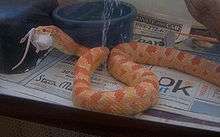
A predator is usually a carnivore that hunts, kills and eats other animals. For example, a snake eating a mouse: the snake is considered the predator because it is consuming the mouse. In another example, a striped marlin is a predator. It lives in the Pacific Ocean and preys on sardines, also a Pacific animal. Similarly, various birds eat earthworms.
However, a predator can become the prey of another larger predator; for instance, a snake may become a meal for a hawk.
"In ecology, predation is a mechanism of population control. Thus, when the number of predators is scarce, the number of prey should rise. When this happens, the predators would be able to reproduce more and possibly change their hunting habits. As the number of predators rise, the number of prey decline. This results in food scarcity for predators that can eventually lead to the death of many predators."
Because of this, predation is called a "positive-negative" relationship. (Campbell) There is also Cannibalism. It is a more grade of predation. This is where in one population the organisms eat each other due to scarcity of food sources. (Lurdes Isufaj) Ex. Frogs are known for cannibalism too.
Herbivore–plant predation

The prey does not necessarily have to be an animal, but can also be a plant. When prey is a plant, the relationship would be called an herbivore plant relationship.
A perfect example of this would be," Galapagos tortoises e cactus plants that grow on the Galapagos Islands." (Bar-Yam, 2011).
Another example are the koalas. They have a special digestive system that allows them to break down tough eucalyptus leaves and remain unharmed by its poison (National Geographic).
Finally, a squirrel is the herbivore (predator) and the nuts he eats are the plant (prey).
Diagraming predator–prey relationships
- Food Webs

- The species that make up an ecosystem are connected in complex "food webs" of eater and eaten. Food webs show interconnectedness, especially between predators and their prey.
- When one species disappears, its predators can no longer eat it and its prey is no longer eaten by it. Changes in these populations affect others.
- Energy Pyramids

- An energy pyramid is a way of showing how energy flows through an ecosystem specifically on a certain food chain (predators and their prey).
- Energy – The energy for all living things comes from the sun
- Producers – Plants that capture the light energy and turn it into chemical energy (stored in sugar)
- Consumers – Organisms that can't make their own food
- Carnivores – Consumers that eat animals
- Ex. Chetha eat Mouse
- Herbivores – Consumers that eat plants (producers)
- Ex. Chipmunks and Armadillos
- Omnivores – Consumers that eat both animals and plants
- Ex. Badgers
- Scavengers are consumers that eat dead animals
- Ex. Vultures
- Decomposers are consumers that eat and/or break down waste products
- Ex. Fungus and Mold
- Carnivores – Consumers that eat animals
- Process for making an energy pyramid
- 1. Start with a food web
- 2. Find a food chain within the food web
- 3. Identify the trophic levels (Trophic Level-Steps in a food chain/energy pyramid)
- 4. Add the source of energy (usually the sun, but may also be chemosynthetic bacteria found near underwater volcanoes.)
- 5. Show the amount of energy in every movement
- 6. Show the energy that is lost
- Process for making an energy pyramid
Competition
Competition is when organisms compete for the same resources. This is a negative relationship because both organisms are harming each other (Campbell).
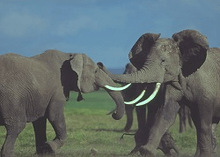
Intraspecies competition
Organisms competing can be from within the same species for example, two male elk fighting for a female mate. Elephants also fight each other so that the dominant elephant will get to breed with the female.
Another species that shows great competition between each other are the dolphins. Dolphins go along together and play with each other, but when it is time to eat; all dolphins have to compete for a meal.
Interspecies competition
Competition can be also found in two different species. A lizard and a frog can compete for a similar food they eat such as a small insect. This type of competition is only found when two different species share an ecological niche that they must compete over.
Competitive exclusion principle
"Direct competition between different species almost always produces a winner and a loser- and the losing species dies out," or is forced to migrate to another ecosystem which can support them (Levine, 2010). This is the competitive exclusion principle. This principle says that two species that need the same resources cannot survive together in the same habitat. One organism will eventually die off, thus, called.
Symbiotic relationships
Mutualism
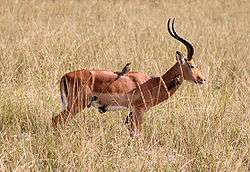

in which organisms benefit from each other. This is a positive relationship.
An example of this would be the bee and flower. Bee gets nectar and honey from flower. The bee contributes back to the flower by spreading the pollen so that the flowers can reproduce.This is a very common contribute to both the flower and the bee, they both rely on each other to survive.
Another example would be when the ox pecker lands on an impalas back and eats the ticks that are a parasite to the impala. The ox pecker is benefited because it gets a meal from the tick and the impala gets benefited because the tick is no longer on it. Similarly, monkeys pick fleas from other monkeys which benefits both because its like a treat.
There is a mutualistic relationship between spider crabs and algae. The algae live on the crabs' backs, allowing the spider crab to blend in with its environment, so that predators can't find them. The algae get a nice place to live, while in turn, the spider crab gets camouflaged. Thus, both organisms are benefited. The Clownfish and Anemone would also be a good fit for mutualism because the Anemone protects the clownfish while the clownfish protects the Anemone. "The clownfish benefits by having a protected home territory."
Finally, there is even a mutualistic relationship within the human body. Bacteria live inside our intestines (getting a good place to live) and help us break down our food and get vitamins.
Commensalism
Commensalism is a relationship in which one organism benefits from another organism that is not affected. This is a positive, neutral relationship. (Campbell)
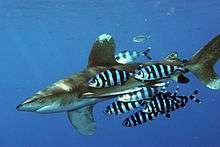
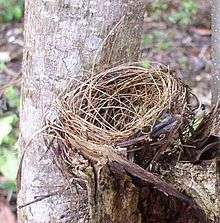
For example, a small fish called the Pilot Fish follows underneath a shark and when the shark eats something the pilot fish eats the scrap pieces of the shark original kill.(Blue Planet BBC Documentary 2001).
Another example is of a birds nest in a tree. The bird is benefitting because the tree is giving the bird shelter and the tree is not getting anything in return.
Similarly, the transparent shrimp benefits from a reef because it hides within it (camouflaging), but the coral is not affected.
Additionally, the relationship between an infectious disease and its carrier, an animal such as a mosquito, could be classified as commensalism because the mosquito is unaffected by the presence of the disease, but the mosquito transfers it to a host in which the disease can reproduce or spread more easily to others.
"Often, the host species provid=nsportation for the other species." (www.Biology-Online.org) The whale and barnacles are a perfect example of this. "Barnacles are crustaceans that have jointed legs and shells of connected overlapping plates. Instead of crawling after food, they glue themselves to rocks, ships, pillings, abalones, and maybe even whales and wait for food to wash by." (Oracle, 2000). The barnacles attach themselves to the whale. This way, the barnacle can get food faster. This does not affect the whale so he does not take the barnacle off.
Parasitism
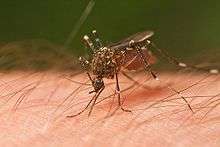
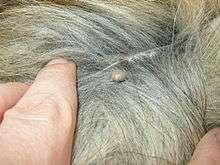
Parasitism is a relationship in which one organism (the parasite) benefits while the other(the host) is harmed. This is a positive, negative relationship. (Campbell)( Dionne L Rice Jr)
The parasite usually lives on or inside the other organism.
For example, mosquito is a parasite, feeding on a human while transferring the disease called Malaria. Other examples would be ticks or fleas that live off of many large mammals. Similarly, head lice are an example of parasitism because they feed on blood from the humans head.
In Colorado, the pine bark beetle is a common parasite. The pine beetles lays its eggs in the pine trees, and then when the babies are born, they eat the layers of the tree which stops the tree from growing. (Robbins)
"Natural Selection favors parasites that are best able to locate hosts and feed on them."(Cambell, 1996).
References
- The Blue Planet. BBC Documentary. 2001
- Bar-Yam, S. (February 28, 2011). Predator-Prey relationships. Retrieved May 4, 2011, from NECSI: http://necsi.edu/projects/evolution/co-evolution/pred-prey/co-evolution_predator.html
- Cambell. (1996). Mutualism. In Biology 4th edition (pp. 1120–1133). The Benjamin/Cummings Publishing co.
- Levine, M. a. (2010). Biology. Pearson.
- Oracle. (2000). barnacles. Retrieved May 5, 2011, from Oracle: http://library.thinkquest.org/J001418/barnacles.html
- The American Heritage® Dictionary of the English Language, Fourth Edition copyright ©2000 by Houghton Mifflin Company. Updated in 2009. Published by Houghton Mifflin Company. All rights reserved.
- Nearctica.com, Inc. 2004. All rights reserved.
- Tommy E. Wynn, Biology Today, (1991), Pgs 832–833, Holt, Rinehart and Winston, Inc. ISBN 0030353572
- BSCS (2006) Kendall/Hunt Publishing Co
- Buzzle.com. (2010, 7 30). Mutualism Relationships. Retrieved May 5, 2011, from Mutualism Relationships: http://www.buzzle.com/articles/mutualism-relationships.html
- Heller., H. (November 2, 2005). Trophic links. Retrieved May 5, 2011, from Predator/ Prey relationships: http://www.globalchange.umich.edu/globalchange1/current/lectures/predation/predation.html
- Campbell, Biology 4th edition, Benjamin/ Cummings, publishing co. pg 1122, pg 1133
- Marris, Emma. "Ecologists propose ousting species to save ecosystems", Scientific American .http://www.scientificamerican.com/article.cfm?id=ecologists-propose-oust
- Hadhazy, Adam. "The Wolf and the Moose: Natural Enemies That Need Each Other", Scientific American.http://www.scientificamerican.com/article.cfm?id=the-wolf-and-the-moose
- Levy, Sharon. "A Top Dog Takes Over," National Wildlife Federation, Online Magazine http://www.nwf.org/news-and-magazines/national-wildlife/animals/archives/2003/A-Top-Dog-Takes-Over.aspx (2003).
- "Predation – Definition from Biology-Online.org." Life Science Reference – Biology Online. Web. May 5, 2011. <http://www.biology-online.org/dictionary/Predation>.
- Bar-Yam, Shlomiya, Predator-Prey Relationships, Evolution, (2011), http://necsi.edu/projects/evolution/co-evolution/pred-prey/co-evolution_predator.html
- Bar-Yam, Shlomiya, Mutualistic Relationships, Evolution, (2011), http://necsi.edu/projects/evolution/co-evolution/mutualistic/co-evolution_mutualistic.html
- Campbell, (1996), Biology 4th Edition, Pages 1120–1133, The Benjamin Cummings Publishing Co., ISBN 0-8053-1940-9
- Khan, Sumaiya, Examples of Commensalism, Buzzle.com, (2010), http://www.buzzle.com/articles/examples-of-commensalism.html
- Hunziker, Derek, Scabies, Human Skin Parasites & Delusional Parasites, (2005), http://delusion.ucdavis.edu/scabies.html
- Sea Lions Recognize the Local Competition, Wild Mammal Blog, (2010), http://www.wildmammal.com/index_files/sealion_barks.html
- Jim Robbins. "Bark Beetles Kill Millions of Acres of Trees in West." November 18, 2008.
External links
- http://animals.nationalgeographic.com/mammals/koala/
- http://www.britannica.com/EBchecked/topic/7924/Africa/37160/Ecological-relationships
- www.philadelphia.edu.jo/courses/biology/Ecological%20Relationships.ppt
- www.slideshare.net/brittgow/ecological-relationships
- Examples of Mutualism: http://www.cbu.edu/~seisen/ExamplesOfMutalism.htm
- http://delusion.ucdavis.edu/scabies.html
- http://www.fcps.edu/islandcreekes/ecology/relationships_page.htm
- http://niral_bhavsar.home.comcast.net/~niral_bhavsar/coniferous/ecologicalrelationships.htm#predatorprey
- http://www.scientificamerican.com/article.cfm?id=ecologists-propose-oust